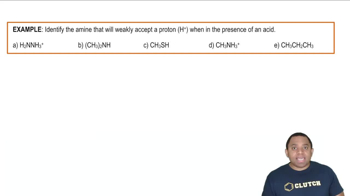Textbook Question
Write the formula for the conjugate base of each acid. b. H2SO3
839
views
 Verified step by step guidance
Verified step by step guidance



Write the formula for the conjugate base of each acid. b. H2SO3
Write the formula for the conjugate base of each acid. c. HCHO2
Write the formula for the conjugate base of each acid. d. HF
Both H2O and H2PO4– are amphoteric. Write an equation to show how each substance can act as an acid and another equation to show how each can act as a base.
Classify each acid as strong or weak. If the acid is weak, write an expression for the acid ionization constant (Ka). a. HNO3
Classify each acid as strong or weak. If the acid is weak, write an expression for the acid ionization constant (Ka). b. HCl